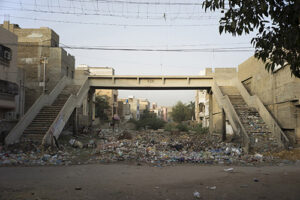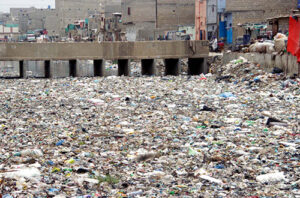According to one estimate, Karachi generates 12000-15,000 tons of waste on a daily basis. However, only 8000-10,000 tons of it reaches the city’s two landfill sites. The rest is burnt, dumped into the sea for reclamation of land, or off-loaded into the natural drains, leading to major issues such as urban flooding during the rains and environmental degradation. Moreover, the garbage which reaches the dumping sites poses its own risks.
This situation provides us an insight into the issue of solid waste management in Karachi, which is neglected at many levels, and exposes the vulnerable population to a countless risks. Limited solid waste management services and resultant piles of uncollected refuse are a major challenge in informal settlements. This link between informal settlements, waste management issues, and clogged natural drains of Karachi tells a story of under-development and neglect of a city.
In 2014, the Sindh Solid Waste Management Board (SSWMB) was formed to improve the chronic situation of solid waste management in Sindh, including Karachi. The SSWMB is now responsible for collecting garbage from designated points throughout the city using specialised vehicles and designated staff and machinery and taking it to the transfer station, and then finally to the city’s two landfill sites: the 500-acre Deh Jam Chakro, located 30-35 kilometres from Karachi, and Gond Pass near Hub River. With time, the SSWMB contracted out these functions to contractors in four districts of the city, in the hope of achieving their objective in an efficient manner. However, the August 2020 monsoon urban flooding revealed the shoddy job done by them. Huge amounts of garbage were left within the city environment, particularly in the natural drains.

An efficient waste management system involves various steps namely, door-to-door collection of waste, its storage and sorting at transfer stations and then its transport to the landfill site. In more developed, high-income countries, the first step involves human contact with the waste, while the second step involves partial involvement of humans and machines; the later stages are largely dependent on machines. In Karachi, the first two steps involving primary storage at home and then carrying it to the secondary storage at the neighbourhood level are human-intensive, and it is here that the whole issue of waste management becomes critical.
At the household level, storage and sorting of garbage is almost the same across the city. In most instances, it is not sorted out at all; it is first stored in bins within the house and then transferred to area level secondary storage or dumping locations, depending on the locality. In high and some middle-income formal localities, door-to-door collection is done by designated municipal or private sweepers, who take the waste to secondary storage either on trolleys, donkey carts or motorised vehicles.
In low-income areas, door-to-door collection is a major issue, as it does not exist or is done only partially due to various reasons. Municipal sweepers are few in numbers, as any new recruitment of sweepers in the KMC has been banned for the last 25 years. None of the municipal sweepers are formally assigned to do door-to-door collection. All of them do it informally, against mutually agreed monthly payments from the residents, which many of the low-income settlement residents cannot afford or do not agree to pay, as they find it easier to toss the waste outside the house.
Those sweepers, private or municipal, who do door-to-door collection in low-income settlements, face a number of issues. The streets are not even or wide enough to use motorised vehicles or donkey carts or even trolleys in some cases. The distance between the location from where they collect the waste and the secondary storage site is sometimes so far that it is practically not feasible for the sweepers to unload the waste at the dumping site multiple times a day. As a result, sweepers and the residents at such locations, where door-to-door collection is not possible or not done, find it easier to dump their garbage in the nearby open plots, alongside the roads, and in the natural drains.

Natural drains in the city seem to be the most convenient alternative secondary storage or dumping site for waste in the city. Sweepers, residents and scavengers find it easier to throw the waste in drains, due to the aforementioned reasons. Also, as these are usually at a depth compared to the surrounding areas, it is easier to empty the trolley or throw the garbage bag, assuming that the sewage water will carry it away immediately; if not, the rains will wash it away. However, the scale on which the waste is being dumped results in the clogging of drains, lowering their carriage capacity and causing severe urban flooding during times of rain. The location for waste disposal also moves with the monsoon rains. However, in certain instances, it is burned regularly by the municipal staff or waste-pickers, causing air pollution.
Karachi, during the monsoons of 2021, saw a record-breaking downpour, leading to severe urban flooding in the city. People suffered heavy losses; their properties and vehicles were inundated; many lives were lost and parts of the city remained paralysed for several days. The natural drains of the city, that were clogged due to waste dumping, silting and encroachments, were largely blamed for the situation.
Informal settlements or katchi abadis of low-income groups are a grim reality of this city. During planning processes, formal residential developments are located at a safe distance from natural drains, to protect them from the danger zones of flooding and landslides. However, due to a shortage of formal housing for the poor in the city, coupled with the existence of politicised organised groups or the land mafia, informal settlements have sprung up at such locations in the city over a long period of time and are now a socio-physical reality of this city that cannot be wished away.
The State has found an easy solution to deal with issues of solid waste management in low-income settlements, clogging of natural drains and the resultant urban flooding: eviction of people living alongside the natural drains, such as the Manzoor Colony Nullah, the Orangi Nullah and the Gujjar Nullah, by destroying hundreds and thousands of houses built alongside these natural drains. However, without addressing the issue of housing for the poor and the faulty solid waste management practices in the surrounding localities of the drains, this problem cannot be resolved permanently, and similar urban flooding situations will keep cropping up from time to time.
If the SSWMB is responsible for solid waste management in the city, then it should acknowledge that waste management is a multi-disciplinary issue and cannot be seen in isolation. It should take responsibility for the door-to-door collection of waste throughout the city, without any discrimination between the formal or informal settlements. It must be borne in mind that urban flooding, pollution and water-borne diseases are connected to the issue of waste disposal. Furthermore, all these issues impact the environment and the city at large.
Lastly, keeping in view the socio-economic realities, a solid waste management system that is completely dependent on machines would not be a sustainable solution. Substantial investment is required in human resource development; the staff needs to be well-trained to address the issue. Additionally, the issues of unclear municipal jurisdictions and institutional divides within the SSWMB and KMC need to be addressed, as the latter oversees the sweeping of the roads, while the former is responsible for solid waste management, although the two tasks are intrinsically connected and should not be separated.
Academia and researchers also need to further investigate and disseminate possible ways forward. A research project titled, ‘Rubbish, Resources and Residues,’ has been initiated by the London School of Economics (LSE), which is investigating the need for integrated approaches to solid waste management with Karachi and Faisalabad serving as two case studies from Pakistan. The project aims to engage with the municipal government in terms of capacity-building and policy recommendations. Hopefully, such efforts will develop a synergy between theory and practice for the betterment of all stakeholders — and the city.

The writer is an Assistant Professor, Department of Architecture and Planning, NED University of Engineering & Technology.

